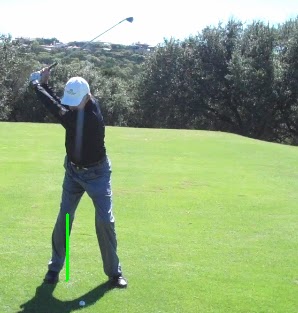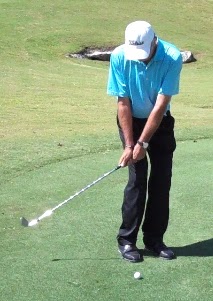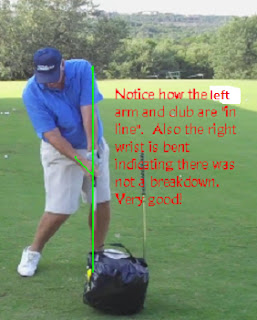If you look at any tour caliber player (male or female) you will notice they all look very similar in the set up position. It's almost like they all read Golf 101 "The Set up". But, as an instructor, a poor set up is the #1 issue I see among the majority of amateur players.
A great set up will allow you to reach your full potential as a golfer!
To me, the proper set up is easy. Follow these instructions to get the "feel" of an athletic set up:
1. Without a club, I want you to stand erect with your feet shoulder width apart.
2. Now raise your arms about shoulder height and place the palms of each hand together with the thumbs pointed up. You have formed a triangle between the arms and shoulders.
3. The goal is to now get the arms or triangle to hang in front of you. To accomplish this first lower the arms until your chest stops them. To get them to hang in front of you, bend from your hips as you let your shoulders drop forward. Try to maintain a fairly straight but not stiff back as you do this. When the arms are hanging straight down from your shoulders, this is where you stop.
4. Now put a small amount of bend in the knees, relax the arms and put your hands in a golf grip position.
5. Your weight should be balanced left to right and back to front.
After repeating this exercise a few times, have a club nearby and place it in your hands after completing the last step. It won't be long until you can get in this athletic position every time with a club in your hands.
Here is a front view of the proper set up. One thing to note is the position of the right knee. Even though I am balanced, I do put a little pressure on the inside of the right foot to keep me centered over the ball on the backswing. This move also allows me to turn and not sway on the backswing. I do this by positioning my right knee about 3-4 inches inside my right foot. Also, it is plain to see the "triangle" formed by my arms and shoulders.
From a down the line look, it is plain to see my arms hanging from my shoulders. Also, my head is in line with my spine and my chin is not buried in my chest. My knees have a slight bend to them and they are just above my shoelaces. It is not a coincidence the club is setting at 90 degrees to my spine. If my hands were too high at address or above the green line, this would cause too much tightness in the wrists and prevent me from hinging my wrists properly at the top of the swing.
I recommend to check your set up position in front of a full length mirror. Once you associate the correct feel with the correct look, you will be able to duplicate your set up on the course.
Let's briefly look at how a good set up effects the swing.
 |
| A great set up allows me to turn to the top and maintain my original spine angle. |
 |
| Note how my right knee stays braced, yet my hips have turned in the backswing. This position produces power and accuracy! |
 |
| At impact I have retained my original spine angle. Since I turned into the brace of my right leg, it is easy to get off my right side and onto my left through impact. This is evident by the right heel releasing from the ground through the hitting area. |




















